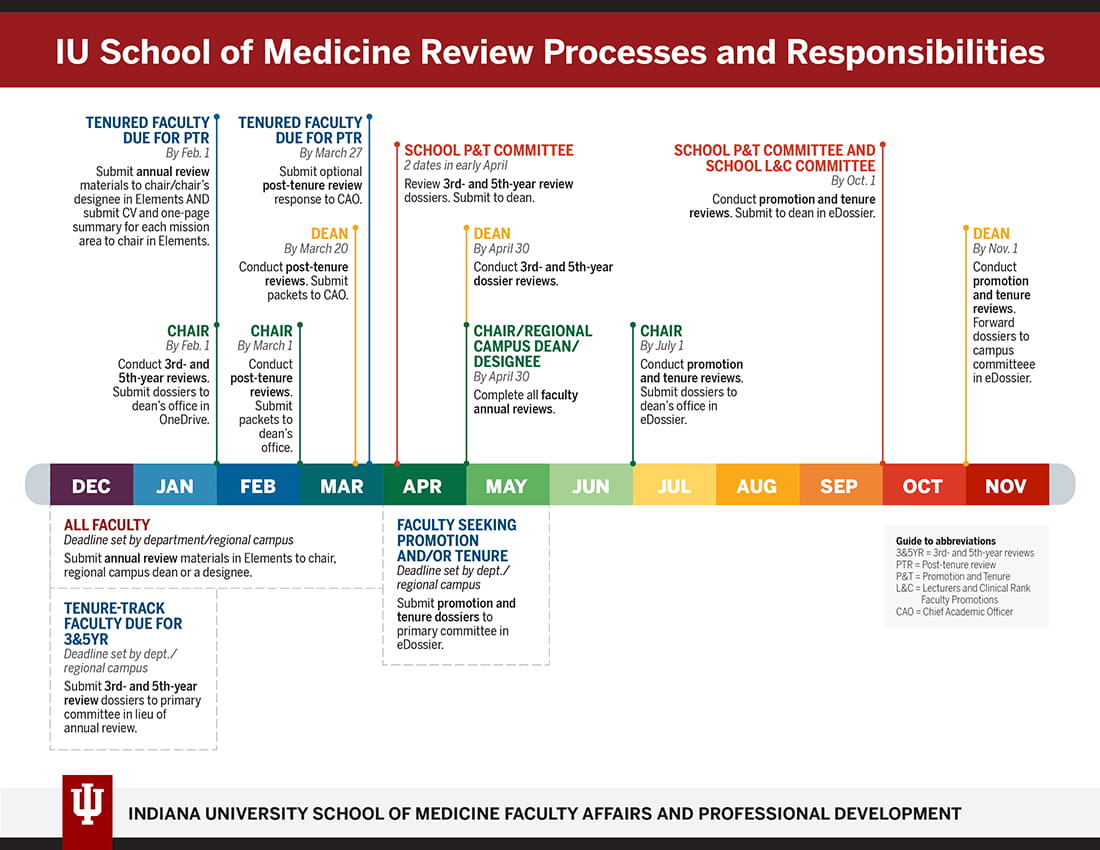Post-tenure reviews are systematic evaluations of performance by tenured faculty over a five-year period. They assess whether faculty are fulfilling their responsibilities in teaching, scholarship (research and/or creative activity) and service, according to the expectations of their departments, schools and Indiana University.
Post-Tenure Reviews

Preparing for Post-Tenure Reviews
IU School of Medicine recognizes that post-tenure reviews can stir a sense of anxiety in faculty. To help you prepare for your first post-tenure review, stay informed. Bookmark this page and plan to revisit well ahead of your first review.
The Indiana University Post-Tenure Faculty Productivity and Annual Review policy — based on requirements of a 2025 Indiana state law — requires all tenured faculty to have a post-tenure review every five years.
When you receive your first review depends on your effective date of tenure.
| Those whose tenure became (or will become) effective in _____... | ...will receive a post-tenure review in spring ____ and every five years thereafter. | |
| Future | Five years after your effective tenure date | |
| 2025 | 2030 | |
| 2024 | 2029 | |
| 2023 | 2028 | |
| 2022 | 2027 | |
| 2021 | 2026 | |
| 2020 or before |
20% of IU Indianapolis faculty granted tenure before 2021* |
2026 |
| Another 20% of IU Indianapolis faculty granted tenure before 2021 | 2027 | |
| Another 20% of IU Indianapolis faculty granted tenure before 2021 | 2028 | |
| Another 20% of IU Indianapolis faculty granted tenure before 2021 | 2029 | |
| Another 20% of IU Indianapolis faculty granted tenure before 2021 | 2030 | |
* For 2026, about 60 of those faculty are from the IU School of Medicine.
Exception: If you have an administrative role (e.g., department chair, director) of 0.5 FTE or greater, you will receive your first post-tenure productivity review five years after your administrative role concludes. You will, however, continue to receive regular annual reviews during this administrative period.
We encourage you to proactively prepare for your first post-tenure review.
- Attend an information session on post-tenure review, Dec. 16, from 9 to 10 a.m. ET via Zoom. This one-hour information session will provide guidance, answers and tools that will help you better understand:
- When to expect your first and future post-tenure productivity reviews
- What will be measured during each review
- How you should prepare for your review
- The process and people involved from start to finish
- What happens with your review results
- And more.
- Familiarize yourself with evaluation criteria.
- Review the draft standard evaluation rubrics for research/scholarship, teaching and service.
(Note that the rubrics are only available on MedNet. You will need to use your IU login credentials to access the page. If you have trouble, try opening a browser you don't normally use — like Firefox or Chrome — or open an incognito/private window, then log in using your Indiana University — not IU Health — credentials.)
- The rubric task forces are currently reviewing all comments and suggestions that were submitted during the open-comment period (Oct. 17 to Nov. 16). They will determine if there is a need for adjusting the rubrics before they are officially adopted ahead of the spring 2026 post-tenure review season.
- Review the draft standard evaluation rubrics for research/scholarship, teaching and service.
- Maintain detailed documentation.
- Get/keep your Elements profile up-to-date. Using Elements is now required for all faculty annual review processes. The reports generated from your faculty annual reviews form the building blocks of post-tenure reviews. Be sure your profile includes all activity for all years covered during your review.
- For those who will be undergoing a post-tenure review in 2026, it will not be necessary to have five years’ worth of activity entered into Elements. Instead, be sure all activity from the 2025 calendar year is entered into Elements, and then focus on writing your one-page summaries (detailed below).
- For those undergoing post-tenure reviews in 2027 or beyond, be sure you have the past five years’ worth of activity data entered into Elements.
- Keep an up-to-date curriculum vitae (CV), as well as a summary of accomplishments in each of the three domains: Teaching, scholarship and service.
- Get/keep your Elements profile up-to-date. Using Elements is now required for all faculty annual review processes. The reports generated from your faculty annual reviews form the building blocks of post-tenure reviews. Be sure your profile includes all activity for all years covered during your review.
- Craft your post-tenure productivity review packet, including:
- Your current CV
- A one-page summary for each domain (teaching, scholarship and service), summarizing your accomplishments over the review period.
- Include both quantitative metrics (publications, citations, grants, student evaluations, service roles) as well as qualitative narrative (explanation of context, challenges, innovations, collaborations).
- Integrate clinical, translational, education and service metrics (e.g., clinical productivity, patient outcomes, curricular innovation, external funding, committee work) into your narrative and documentation.
RESOURCE | Download guidelines for preparing post-tenure review one-page summaries
- Anticipate questions and possible areas of concern, such as gaps or less active periods in your record.
- Prepare brief explanations.
- Be ready to show plans for how to strengthen future performance.
- Submit your post-tenure review packet to your chair or chair’s designee in Elements by Feb. 1.
- Use feedback proactively. Use all feedback — positive, negative or mixed — as a roadmap for your next cycle of productivity and development.
Answers to FAQs
The Academic Leadership Council has published answers to frequently asked questions about post-tenure and faculty annual reviews. There, you can find answers to questions like:
- Are there templates for post-tenure productivity review letters and performance improvement plans?
- Are individual departments and units responsible for identifying specific criteria for post-tenure productivity reviews?
- What happens if a faculty member did not receive an annual review of their performance during part or all of the previous-five-year window that is covered in their post-tenure productivity review period?
- And more
Annual review information and Elements training
See the Faculty Annual Reviews page for detailed information about training opportunities and resources related to annual reviews and Elements, based on your role (reviewer or reviewee).
Resources
- DOWNLOAD | Guidelines for Post-tenure Review One-page Summary – Research
- DOWNLOAD | Guidelines for Post-tenure Review One-page Summary – Teaching
- DOWNLOAD | Guidelines for Post-tenure Review One-page Summary – Service
[COMPLETE!] Info Session: Post-Tenure Reviews
Dec. 16, 9 to 10 a.m. ET, via Zoom
This one-hour information session will provide guidance, answers and tools that will help you better understand:
- When to expect your first and future post-tenure productivity reviews
- What will be measured during each review
- How you should prepare for your review
- The process and people involved from start to finish
- What happens with your review results
- And more
[COMPLETE!] Town Hall: New Faculty Annual Review Standard Rubrics
Nov. 6, 3:30 to 4:30 p.m. ET, via Zoom
Elected faculty officers, task force co-chairs and members of FAPD will explain the new, standardized performance rubrics and how they pertain to post-tenure review, answer questions and address comments. The session will not be recorded; plan to attend the live webinar.
Learn more
About Post-Tenure and Faculty Annual Reviews
